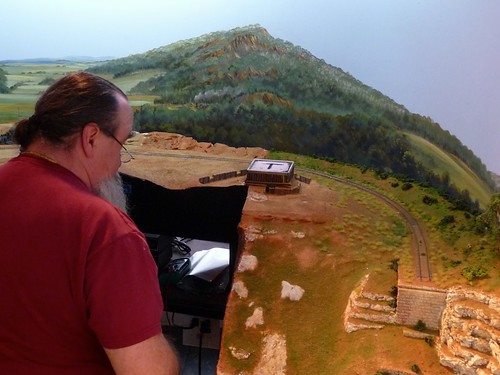The following photos attribute the recent work projects with their respective authors. I use this term author deliberately since the skills that each person brings is at a level where I trust their ability to "author" their sense of a scene or scene element.
LeBron, on his January 2013 visit, has painted, inserted and here is dry brushing the perimeter fence (Musket Miniatures) of the Barnsley Estate. Godfrey Barnsley, if you missed prior postings, was a cotton trader. With offices in Atlanta, New Orleans, Savannah and London, interestingly he was opposed to slavery and paid all his workers.
He was also known for his extraordinary gardens, some of which we plan for the center section just in front of his home. This mansion was scratch built by Christopher from book illustrations in Barnsley Gardens. You can see Chris' work under LABELS for Barnsley.
The BLOCKHOUSE
 One of the latest projects is the addition of a blockhouse. These were built close to rail lines to protect against enemy raids. Most pictures of the period are the more sophisticated USMRR type found built into bridges and/or of multiple sides.
One of the latest projects is the addition of a blockhouse. These were built close to rail lines to protect against enemy raids. Most pictures of the period are the more sophisticated USMRR type found built into bridges and/or of multiple sides. I found this photo captioned on the N&C (Nashville and Chattanooga) RR and it was near Chattanooga. I loved the idea of a blockhouse scene and decided this is plausibility enough to fashion one on the W&A.Once Barnsley's Mansion was completed, Christopher laid claim to this project. A brief bio on Chris, he has been a military modeler since I met and worked with him at a military miniature hobby shop, The Lead Soldier, in Trenton, NJ. Professionally he is a finishing carpenter. He approaches model building with the same eye for accuracy and excellence.
Positioned near the entrance to Chattanooga's yard, Chris prepped the area so as to lay the structure higher than the tracks and flat giving it a reasonable distance from the tracks. Built on pink insulation foam, he added Sculptamold and Georgia dirt to form the landscape. The entrance begins the log barricade base. The resin gun emplacements are Musket Miniatures.
Christopher shaped a solid piece of pink foam as the form to build this structure, since no interior is planned, and painted it black. Finding sticks in his yard he first baked them to ensure they would be dry as well as a preserving process. He next measured the walls and began cutting vertical logs. Prior to adhering these to the insulation, he notched the sides of two for rifles and muskets. Door is scratch built of wood.

Vertical logs attached, Chris has added the upper planking and now the second, horizontal layer of logs. Currently he is completing the roof.
The view below is looking south across the Howe Truss over Chickamauga Creek. There is no evidence I could uncover to verify blockhouses were built on this line. However it's plausible and as they say, its your railroad.
The view below is looking south across the Howe Truss over Chickamauga Creek. There is no evidence I could uncover to verify blockhouses were built on this line. However it's plausible and as they say, its your railroad.

 |
| Christopher assessing his work |
WIRE TREES
Andy has been our resident tree builder. Learning as he goes, he has produced some beautiful work. See these under LABELS - Andy, Crew. Andy also shoots most of our videos and many of the photos shown here and on the Flicker pages.His recent endeavor with trees were made of wire. There is a type of pine abundant in GA so wire was the economical approach. This wire is found in the floral section of craft stores, i.e., Michael's and AC Moore. The left picture shows various tools including the use of a pencil. Andy takes about 16-20 wire strands, cuts them about 18"-22". He then places the pencil in the middle and folds the bundle in half, doubling the number of strands. Once he has twisted the wire into branches, he caulks the trunk leaving about an inch at the bottom as a handle. When nearly dry he shapes the caulk into bark. Once dry he sprays a base coat then uses 3-4 browns and grays.


 | |||||||||||||




No comments:
Post a Comment